As you develop the design concepts for a new assembly, it is useful to create a layout of the preliminary design. The Sketch command in the Assembly environment allows you to draw 2D sketch geometry on part or assembly reference planes.
You can draw assembly sketches on the three default assembly reference planes or you can create new assembly reference planes to draw sketches on.
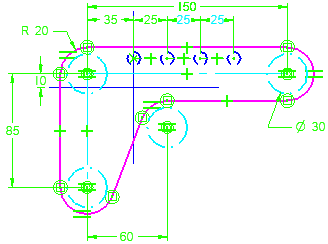
You can use assembly sketches to do the following:
Create 3D ordered geometry within parts.
Create assembly features.
Position 3D parts relative to the sketch geometry.
Position an assembly sketch relative to a 3D part.
Note:
For more information about 2D drawing in Solid Edge, see the Drawing in Solid Edge and Drawing Profiles topics.
Drawing an assembly sketch is similar to drawing a sketch in the Part environment. When you click the Sketch button and then select or define a reference plane, a sketch view is displayed. You can position the new reference plane relative to an assembly reference plane or relative to a face or reference plane on a part in the assembly.
You can use the 2D element creation commands to draw sketches that represent the basic shapes of the parts. You can set style, color, type, and width options for the 2D elements to make it easier to interpret the assembly sketch.
The 2D elements you draw are assigned to the active layer. For example, when working with a complex assembly sketch that will be used to construct several parts, you may want to arrange the elements on multiple layers.
You can add dimensions and relationships to control the position and size of the sketches. You can also define functional relationships using the Variables command. You can use the PathFinder shortcut menu commands to control the display of the sketch elements.
You can also control the display of elements in an assembly sketch by assigning the elements to a logical set of layers, and then display or hide the layers to control the display of the elements.
You can use the Save and Save All commands to save an assembly sketch. When you have finished drawing, close the sketch view using the Close Sketch command on the Home tab.
Your assembly layout might contain representations of many parts and subassemblies, and during the course of design you might choose to copy sketches between documents. You can use the Copy Sketch command to copy assembly and part sketches between documents when working in the context of an assembly. When copying sketches, you use the Copy Sketch To Target dialog box to specify the target document, and whether the copied sketch is associatively linked to the original sketch.
You can use the Tear-Off Sketch command to move or copy elements in an assembly sketch to new reference plane you define.
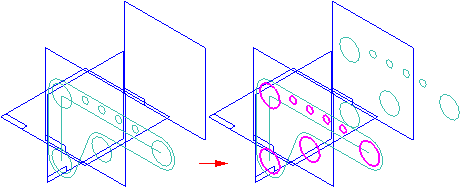
When you copy sketch elements, you can use the options on the Tear-Off Sketch Options dialog box to specify whether the copied elements are associative to the existing elements.
Note:
Assembly sketch geometry can be associatively linked to drive the creation of ordered part geometry only.
When you create or modify a part or subassembly in the context of the assembly, you can use your assembly sketches to construct part profiles and subassembly sketches. You can also use the sketch elements to construct assembly features. For example, you can use the Include command to include an element from an assembly sketch to a part profile or to include an edge from a part to the assembly sketch.
To associatively include an assembly sketch element, you must first set an option on the Inter-Part tab on the Options dialog box: Allow Inter-Part Links Using: Include Command In Part and Assembly Sketches. Then, on the Include Options dialog box, set the Allow Locate of Peer Assembly Parts and Assembly Sketches option and the Maintain Associativity When Including Geometry From Other Parts in the Assembly option.
Note:
For more information about working with associative links between parts and assemblies in Solid Edge, see the Inter-Part Associativity topic.
A special relationship handle is added to any linked profile element (A) to indicate that it is linked to an element in another document. You can break a link by deleting the relationship handle for that link.
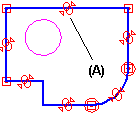
You can position parts and subassemblies with respect to a part or assembly sketch. You can position 3D components using assembly relationships, such as mate and planar align; or using 2D dimensions and relationships, such as distance between and connect.
While editing an assembly sketch, you can use the Parts Library tab to add new components to the assembly.
You can use assembly relationships, such as mate, planar align, connect and axial align, to position a part to a keypoint or a line on a part, subassembly, or top-level assembly sketch.
For example, it can be difficult to position a bolt in a slot using faces. In this example, a bolt part is positioned to a point element on a part sketch.
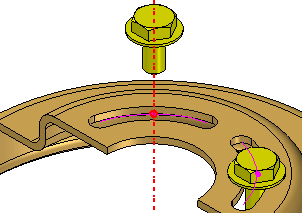
An inferred axis that is perpendicular to the reference plane of the sketch on which the point lies defines the axis for the axial align relationship. The arc and point were drawn such that if the size or position of the slot changes, the arc and point will also update properly.
While you are editing an assembly sketch, you can use 2D dimensions and relationships to position a 3D component relative to elements in the sketch. For example, you can use connect relationships (A) to position roller parts (B) relative to an assembly sketch. When you edit the assembly sketch, the position of the roller parts update. This can be useful when creating a new assembly that uses existing components.
In this example, the value of the 60 millimeter dimension was edited in the assembly sketch to 75 millimeters. Because the roller part was constrained to the assembly sketch using a 2D connect relationship, the position of the roller updated when the sketch dimension was edited.
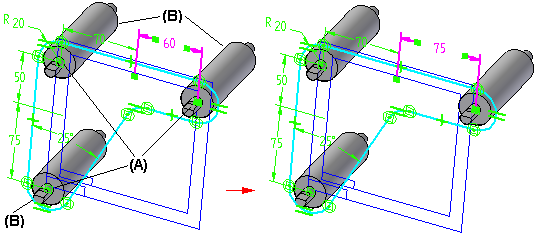
When a sketch window is active, you can use the Select tool and options on the Position 3D Component command bar to specify whether the sketch drives the position of the 3D component or the 3D component drives the position of the sketch. In the previous example, the Sketch Driving option was set for the roller parts to specify that the sketch drives the position of the 3D components.
Note:
When you set the Sketch Driving option, the component symbol in PathFinder indicates that the component is driven by the assembly sketch.
You can use the Select tool to select the 3D component in PathFinder or you can use the Component Select Tool command to select the 3D component in the graphics window. In either case, when you select the 3D component, the Position 3D Component command bar is displayed.
As you choose which relationships and techniques to use when you position components in assemblies, keep in mind the following:
That you cannot use 2D dimensions and relationships to position 3D components that conflict with existing 3D relationships.
When you set the Sketch Driving option for a part, it is with respect to the current sketch. If relationships are available, the part can be driven by or drive another sketch.
You can set the Sketch Driving option for a part in more than one sketch and apply 2D relationships in each sketch until the part is fully positioned. This can make it easy to fully position a part using two or more sketches.
When you set the Lock Alignment option on the Position 3D Component command bar, the part is locked parallel with respect to the sketch plane and the part face you selected. The part can still move and rotate. This can make it easy to fully position a part using one sketch.
You can also constrain elements on an assembly sketch to a 3D assembly component such that if the size, shape or position of the 3D component changes, the assembly sketch updates. When you are editing an assembly sketch, you can select a 3D component and set the Component Driving option on the Position 3D Component command bar to specify that the 3D component drives the size, shape, and position of the assembly sketch.
The Sketch and Copy Sketch commands are available only when the Apply Edits to All Members option on the Alternate Assemblies tab is set (you are working globally).
For more information, see the Alternate Assemblies Impact on Solid Edge Functionality Help topic.